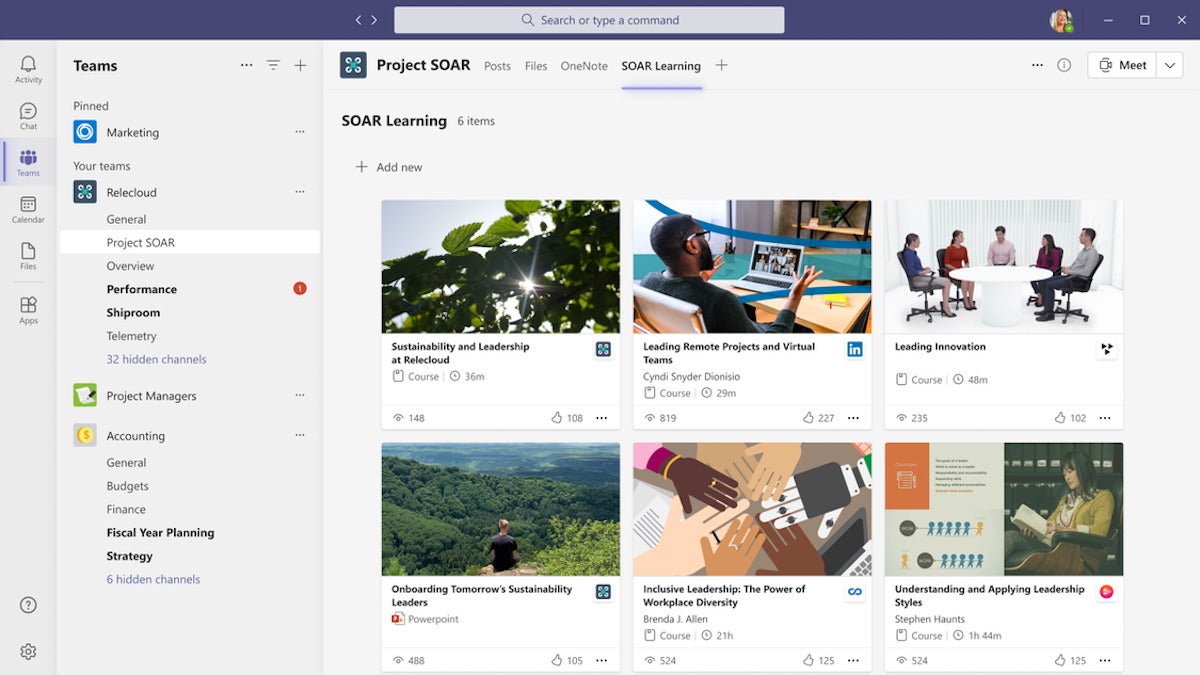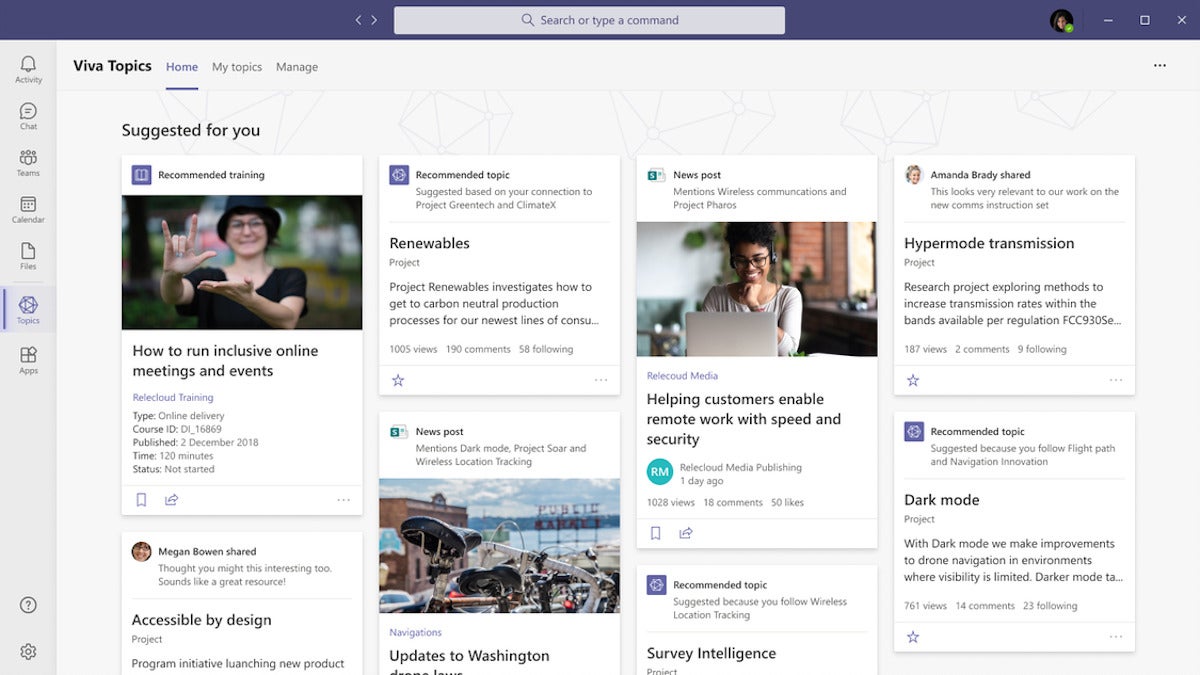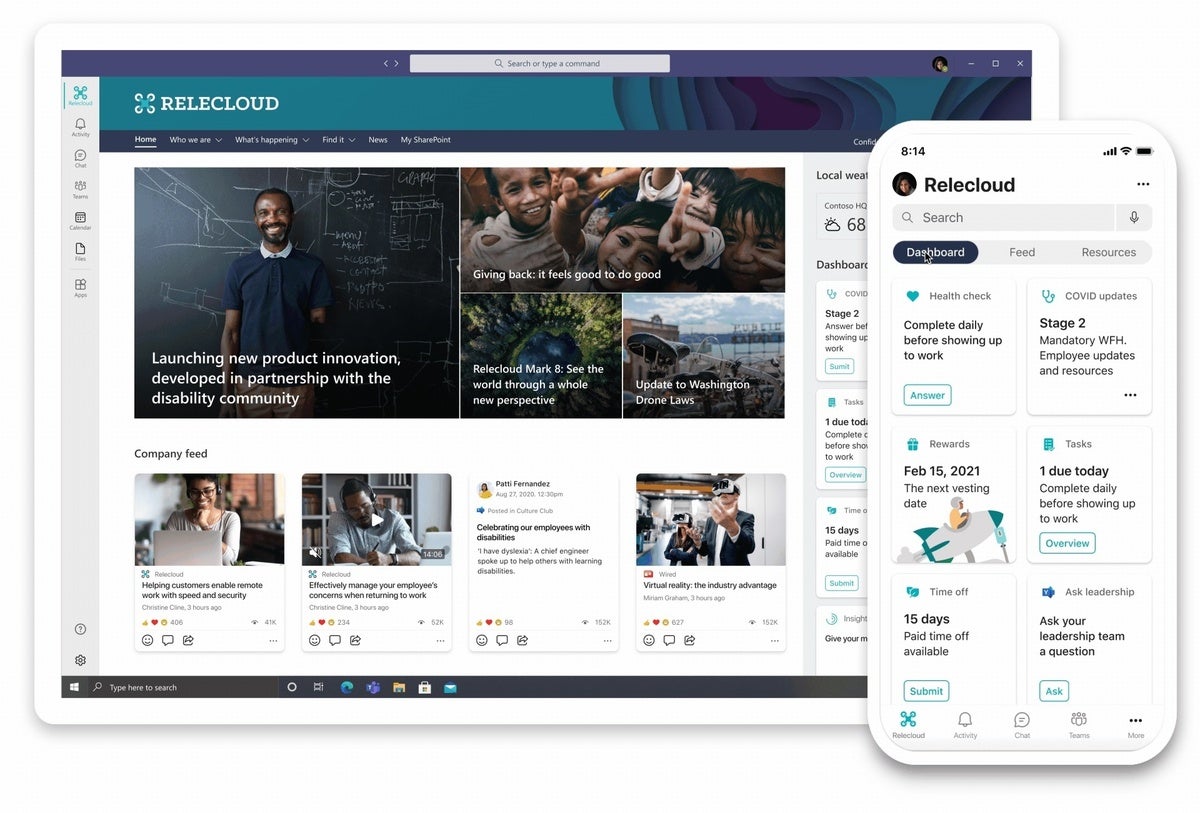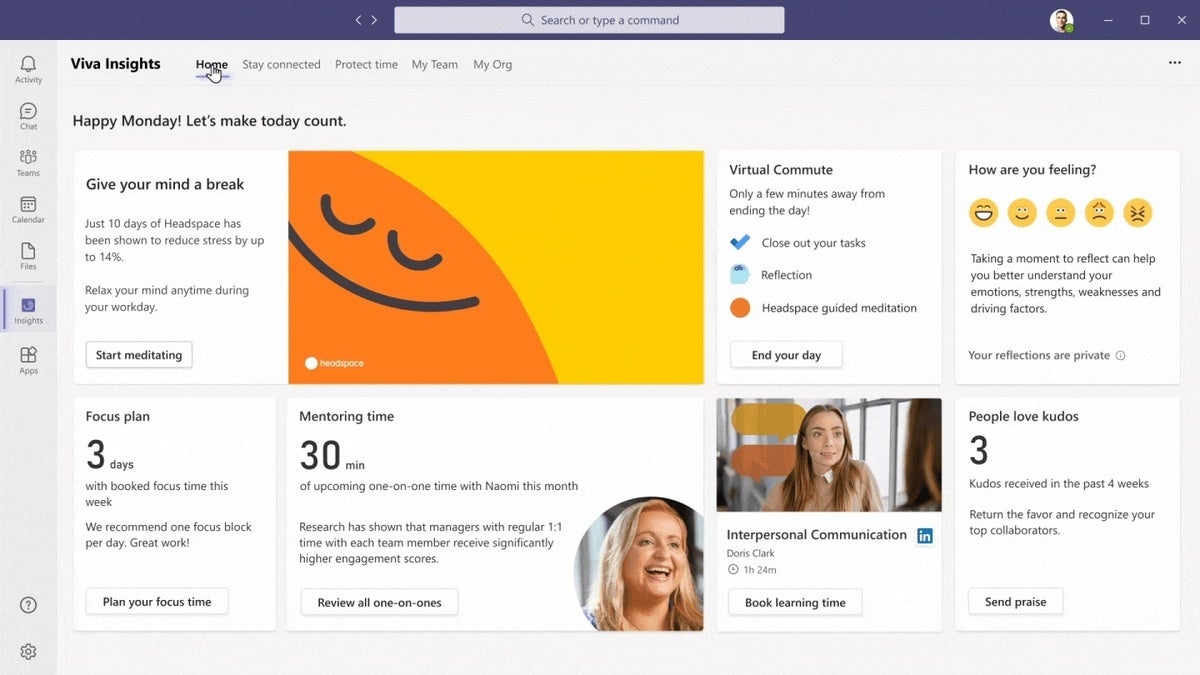Calling employee experience the “new ERP,” Microsoft introduced four Viva “modules” that provide access to workplace learning, knowledge, analytics, and corporate info.
Microsoft today unveiled its employee-experience platform, Viva, which the company calls a digital “gateway” for employees to access relevant news, learning, analytics, and knowledge within their organization.
Four Viva “modules” — Connections, Insights, Learning and Topics — will become available in Teams on a staggered basis over the next few months, Microsoft said, leveraging existing capabilities within the Microsoft 365 portfolio, including SharePoint and analytics tools.
The platform is also designed to provide managers and leaders better insights into the well-being and performance of workers, the company said.
“Today we are bringing together collaboration, learning and well-being, in order to create a complete new product category: [the] employee experience platform or EXP,” Microsoft CEO Satya Nadella said in a pre-recorded briefing ahead of the announcement.
Just as enterprise resource planning (ERP) applications connected accounting and finance to core business operations three decades ago, businesses are now seeking similar alignment with employee-facing systems, Nadella said.
“We believe the same paradigm shift that happened with ERP then will happen with EXP today,” he said. “People operations will no longer be limited to HR, but will be integrated across every aspect of the business in order to improve the overall health and resilience of the organization.
“Every organization will require a unified employee experience, from onboarding and collaboration to continuous learning and growth,” Nadella said. “These can no longer be siloed functions.”
The launch of Viva comes as an enterprise focus on remote workers continues to grow, particularly during the pandemic-driven rise of distributed workforces. Microsoft argues that the “fragmented” market for employee experience tools, covering everything from employee training to benefits, analytics, and other wellness issues, is already worth a staggering $300 billion globally.
“But too often, these technologies are fragmented, hard to find and disruptive to the flow of work,” Jared Spataro, corporate vice president for Microsoft 365, said in a blog post on Thursday.
As companies prepare to support a large remote workforce post-pandemic, interest in tools that track and manage employee experience is on the rise. SAP’s successful Qualtrics IPO and HR software vendor Workday’s $700 million acquisition of employee engagement analytics provider Peakon are two recent examples. And Salesforce in 2020 launched its employee experience platform Work.com.
“Without a doubt, the pandemic has [placed a] bigger focus on employee experience because of the conditions many had to adapt to,” said Carolina Milanesi, a principal analyst at Creative Strategies. “This, in turn, has highlighted the gaps many organizations had when it comes to support, train[ing] and manage talent. …People realized that the way they worked does not reflect the way we should be working. This, coupled with higher visibility given to working conditions, societal issues and upskilling creates a very good moment for Microsoft to deliver an holistic platform.”
Microsoft’s existing strengths around workplace productivity — and the boom in Teams use, which now has 115 million daily active users — put the vendor in a good position to introduce employee experience capabilities, said David Johnson, a principal analyst at Forrester.
“Microsoft understands how important technology is in people’s daily working lives, that it is a huge part of their overall employee experience,” said Johnson. “Drawing awareness to this and creating solutions to help companies create a better experience for their employees is a good move.”
Milanesi also noted that Microsoft has a wider reach than most companies focused on employee experience. “The biggest advantage that Microsoft has is that it builds on solutions that are already present in many organizations — like Yammer — and leans into a strong cloud- and AI-enabled platform. Other solutions are more limited in scope and do not necessarily get the advantage of plugging into as many resources and will be judged on a much narrower return, which might bring more scrutiny to their cost.”
For Microsoft 365 customers, the launch of Viva could allow IT to play a more active role in managing and coordinating employee experience for their organization.
“Unless we work in HR, most of us don’t use HRIS [HR information system] software every single day; we use Microsoft or other productivity software to get our jobs done,” said Johnson. “What [the Viva launch] is doing is to make the CIO’s role in employee experience much more prominent, something that we’ve been predicting for several years.
“By integrating capabilities into Teams, it puts them more in the flow of people’s work, and most importantly, it raises awareness.”
Viva Connections
The shift to remote work has affected employees’ sense of community and belonging within their organization, especially for new hires, with 60% of workers feeling disconnected since going remote, according to Microsoft research.
Viva Connections is a personalized digital workplace built on SharePoint. From here, employees can access a range of content, including internal company news, policies and benefits, and interact with various groups and communities, thanks to integration with Microsoft apps including Yammer, SharePoint, and Stream.
Microsoft
Each employee gets a personalized news feed, which internal communications teams can use to highlight important information — it’s accessed in the dashboard that serves as the Viva homepage.
The Connections app can be customized with corporate branding and curated content to target groups of employees with focused information and tools.
Connections is slated to be available on the Teams desktop app in the first half of 2021, with the mobile app following in the summer.
Viva Insights
An analytics tools, Viva Insights, is aimed at both individual employees and managers and can track productivity and well-being at a personal and business-wide level.
Viva Insights, which replaces two existing Microsoft 365 tools — MyAnalytics and Workplace Analytics — will offer an overview of productivity levels, said Microsoft. The goal is to ensure employee well-being and avoid burnout by, for example, detecting when an employee has too many meetings and not enough focus time.
Additional features such as virtual commutes and integration with the Headspace meditation and mindfulness app will be available in the “coming months,” along with an integration with Viva Learning.
Microsoft
In addition to tapping into data from Microsoft’s own products such as Teams and Outlook, Viva Insights will incorporate data from third-party applications, including video tools like Zoom and HR platforms from Workday and SAP SuccessFactors.
Microsoft has drawn criticism for its Productivity Score tool in recent months, which can allow managers to monitor individual productivity levels. The company said that personal data derived from Viva Insights is only viewable by the individual employee, while higher-level info is accessible by business leaders and managers only after being aggregated and anonymized, with privacy set by default.
Viva Insights can be downloaded for Teams today, with personal insights available for Microsoft Exchange Online users in public preview, and manager insights available to existing Workplace Analytics customers.
Viva Learning
The Viva Learning app for Teams, now in private preview, is a central repository for learning materials. The aim is to help employees easily hunt down information needed to do their job, from training videos to PowerPoint presentations.
Teams users can search and share learning content in chat and create their own “tab” within the collaboration platform to organize their content.
 Microsoft
MicrosoftLearning content is available from a range of sources, from Microsoft Learn and LinkedIn Learning to third-party providers such as Coursera and PluralSight. Viva Learning will also integrate with learning management systems from Cornerstone OnDemand, SAP SuccessFactors, and others.
Viva Learning is currently being piloted with select Microsoft customersl a general release is pegged for “later this year.”
Viva Topics
Finally, Viva Topics is a knowledge management platform that helps an employee access the information that relates to their job role.
Topics uses AI to collect content across an organization into topic areas such as projects, products, or customers, collating information from within the Microsoft 365 ecosystem as well as third-party providers such as Salesforce and ServiceNow. These topic pages are automatically collated by Microsoft’s AI, with an organization’s “experts” able to add and edit the wiki-style pages.
Topic “cards” are also available within Microsoft 365 apps, highlighting topics when they appear in certain messages or other content within apps, providing quick context around unfamiliar acronyms or terms, for example.
Topics are arranged around a “topic center” which will eventually be viewable from Teams and SharePoint, allowing workers to discover content recommended to them based on topics they follow, and personalized by the Microsoft Graph.
Viva Topics is generally available as of today for all Microsoft 365 customers.
 Microsoft
Microsoft
This article originally appeared on ComputerWorld.


